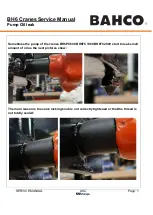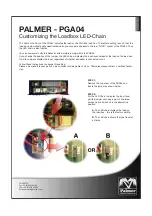
24
Troubleshooting
NEVER apply direct heat to the float. The float may explode due to
increased internal pressure, causing accidents leading to serious injury
or damage to property and equipment.
WARNING
When disassembling or removing the product, wait until the internal
pressure equals atmospheric pressure and the surface of the product
has cooled to room temperature. Disassembling or removing the
product when it is hot or under pressure may lead to discharge of fluids,
causing burns, other injuries or damage.
CAUTION
When the trap fails to operate properly, use the following table to locate and remedy
the cause.
BT3N/MBT3N/PBT3N: Troubleshooting for the Steam Trap and Bypass
Valve
Problem Diagnosis
(Cause)
Remedy
Check to see if the float is damaged
or filled with condensate
Replace with a new float
Check the orifice, screen and the
piping to see if they are clogged with
rust and scale
Clean parts
Check to see if the trap operating
pressure exceeds the maximum
specified pressure, or whether there
is insufficient pressure differential
between the trap inlet and outlet
Compare specifications and actual
operating conditions
No condensate
is discharged
(blocked) or
discharge is
poor
Check to see if steam-locking has
occurred
Perform a bypass blowdown
Check for a clogged orifice or rust
and scale under the float
Clean parts
Check for damage to the orifice
Replace with a new orifice
Check that the float is not
misshapen or coated with scale
Clean or replace with a new float
Check for the improper installation
Correct the installation
Check for trap vibration
Lengthen inlet piping and fasten
securely
Check to see if the bypass valve is
open
Close the bypass valve
Steam is
discharged or
leaks from the
outlet
(blowing)
(steam leakage)
Check the valve sealing surfaces for
dirt or scratches, and the o-ring
(outlet valve seat) for scratches or
damage
Clean or replace parts
Steam leaks
from the bypass
valve gland
Check for dirt, scratches or wear on
the gland packing
Clean or replace parts
Check to see if the valve seat or the
ball have build-up (the ball should
turn easily: normal operation torque
is less than1.0 N·m)
Clean parts
Check the shaft coupling for wear or
deformation
Replace with a new shaft coupling
The bypass
valve does not
move or
remains half-
open
Check the motor unit or actuator unit
(see following pages)
Replace with a new motor unit or
an actuator unit
Check for the gasket deterioration or
damage
Replace with new gasket(s)
Steam is
leaking from a
place other
than the outlet
Check to make sure that the proper
tightening torques are used
Tighten to the proper torque
Float frequently
becomes
damaged
Check to see if water hammer has
occurred
Study and correct the piping
172-65162M-03 (BT3N/MBT3N/PBT3N) 5 Jul 2013




































